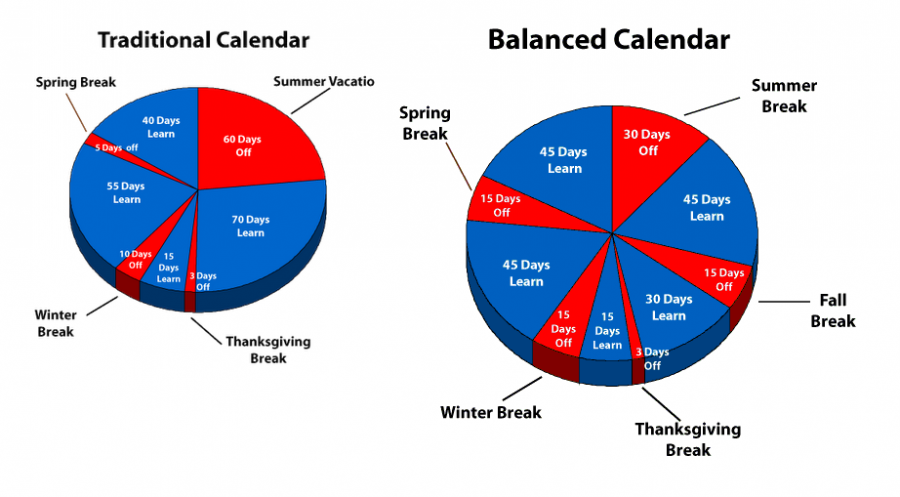Many American schools across the world, including TAS, have kept the same school schedule for years: 180 days of school with a two month summer break and other breaks throughout the school year. However, as society continues to modernize, the need for a more balanced schedule becomes more apparent to accommodate the busy schedules of students and teachers alike.
Proponents of a year-round schedule have risen to challenge the traditional school schedule in an increasingly modern society. In a world of constant updates–be they on Twitter or CNN.com–no one takes a break from information. No one seems to take a break from learning, either–except, it seems, for those whose job it is to learn: students. Many say that as society evolves to become even more modern than it already has, the traditional schedule is obsolete; change is needed. While the thought of abolishing the traditional school schedule in favor of a year long schedule may scare students into thinking that summer breaks are effectively erased, what students fail to realize is that, year-round schedules offer many hidden advantages. These advantages can not only help any student in academics, but also help destress our highly stressful lives.
A big problem for many students when they return to school in fall is that they lose a lot of what they learned in the previous year. This forces teachers to have fall reviews to recover the losses. Studies indicate that students score higher averages on standardized tests in spring than they do when they take the exact same test after summer. The year-round schedule would greatly help students who are struggling with retaining knowledge from previous years as it has been proven to help increase information retention rates in students. The year-round schedule would also restrict the need for fall reviews which would enable teachers to start teaching new materials much sooner to students.
Another issue with traditional school schedules is the risk of students burning out in May. In May, especially, students begin to break down mentally and physically from pressure and exhaustion. This severely distorts a student’s focus and learning capabilities. Year-round schedules help to cover the issue by providing numerous three-week breaks throughout the school year that allow students to rest and recover before returning to school. I believe this would prevent burnouts for students come time for May, which, in turn, would keep students focused on exams and other assessments. If we have more breaks throughout the year, all of us –students and staff–will be more rested and yield better results.
The trend of year-round schedules has caught up in many states in the United States. California, Texas, Minnesota, Florida are among the numerous states that have 11-month school years and many are finding success with the new schedule. Some prominent examples are Minnesota’s Cambridge-Isanti school district and California’s Oxnard school district. The Cambridge-Isanti school district claims that it has had overwhelming success with the year-round schedule; in fact, it has been so successful that parents are arguing for a year-round high school in the district. In Oxnard, school districts have been using year-round schedules since 1976 and the district has claimed that a nine-year analysis shows that academic results have drastically improved with the new schedule.
Despite the success and advantages the new schedule offers, there are not enough supporters of the new schedule. Understandably, students love summer vacation and are unwilling to change it to one month as summer vacation has been the core of childhood memories. Many teachers and parents are also uncooperative in learning and adapting to the new schedules which prevents many schools from adopting new schedules.
These factors inevitably make year-round schedules hard to implement in schools. While I understand that some students and faculty use their summers wisely–by traveling, studying, or working at a worthwhile job–I ultimately think that the benefits of yearlong study greatly outweigh the costs. After all, the mission of TAS says that it wants to encourage students to develop a love of lifelong learning, and learning shouldn’t stop simply because the temperatures are higher.
Year-round schedules offer great advantages for students and teachers that help school become a better learning environment. But until people understand the truth and functionality of the misnomer, the year-round schedule will always be overshadowed by the popular traditional schedule. TAS: let’s rethink the status quo.
Shortened Summer? No Problem
October 18, 2015
0
More to Discover


![A collection of college flags. [PHOTO COURTESY OF AMBER HU ('27)]](https://blueandgoldonline.org/wp-content/uploads/2025/05/IMG_5029-1200x577.jpeg)

![An SAT word cloud. [PHOTO COURTESY OF WORDCLOUDS]](https://blueandgoldonline.org/wp-content/uploads/2025/05/SAT.jpeg)
![Collage of banned books, including “The Handmaid’s Tale” by Margaret Atwood. [MINSUN KIM/ THE BLUE & GOLD]](https://blueandgoldonline.org/wp-content/uploads/2025/04/IMG_4274-1200x681.jpeg)

![A collage of dark romance book covers from an online store for dark romance novels. [PHOTO COURTESY OF TRILOGYOFROMANCE.COM.AU]](https://blueandgoldonline.org/wp-content/uploads/2025/04/IMG_4272-1200x600.png)